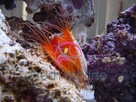Squamosa Clam Cultured - Tridacna squamosa - Scaled Clam
Medium 2" - 3"
Large 3" - 4"
X-Large 4" - 6"

Taxonomy: Squamosa Clam Cultured belongs to the Kingdom Animalia, Phylum Mollusca, Class Bivalvia, Order Veneroida, Family Tridacnidae, Genus Tridacna and Species squamosa.
Scientific names: The scientific name of Squamosa Clam Cultured is Tridacna squamosa.
Other common names: Squamosa Clam Cultured is also commonly known as Scaled Clam, Fluted Clam, Fluted Giant Clam and Scaly Clam.
Origin or natural range: Tridacna squamosa originates from the Indo-Pacific region including the Red Sea and the Great Barrier Reef.
Size: Squamosa Clam Cultured may grow up to a size of around twelve inches to fifteen inches.
Color: Tridacna squamosa occurs in Purple, Green, Gold, Black, Brown, Blue and Yellow colors.
Aggression: Squamosa Clam Cultured is non-aggressive towards the marine aquarium invertebrates.
Venom status: Tridacna squamosa is non-poisonous in nature.
Habit & Habitat:
- In its natural habitat, Squamosa Clam Cultured is found at the sandy bottom and the coral reefs of the marine aquarium water body at a depth of around fifty feet to sixty-five feet from the sea surface. Byssal filaments of Tridacna squamosa help it anchor to the substrate amidst Acropora Corals.
- When disturbed, Squamosa Clam Cultured closes its shell tightly.
- The tube receiving water incurrent is outlined by long tentacles.
Morphology:
- The mantle of Squamosa Clam Cultured is the most striking part in its body as it is spotted in Black color.
- The two symmetrical shells of Tridacna squamosa have large plates, called Scutes, on its surface. These shell plates are used for refuge by various small marine invertebrates such as crabs and the other clams to name some.
- Tank type: To host Squamosa Clam Cultured, you should have a well established Reef Type Marine Aquarium.
- Aquarium set-up: Keep a thick layer of sand at the bottom of your reef tank for Tridacna squamosa to anchor itself in.
- Water flow in the aquarium: Squamosa Clam Cultured needs moderate water flow in the marine aquarium it is placed.
- Temperature of water: Seventy-two to seventy-eight degrees Fahrenheit.
- Specific gravity of water: 1.023 to 1.025.
- pH of water: 8.10 to 8.40.
- Illumination:
- Squamosa Clam Cultured requires high intensity lighting in the marine aquarium it inhabits.
- Halide lighting is recommended for Tridacna squamosa.
- Diet: Squamosa Clam Cultured is Planktivorous in feeding habit.
- Food content: Tridacna squamosa derives its nutrition mainly through photosynthesis which is performed by Zooxanthellae, a photosynthetic algae living symbiotically within the mantle of clam. Squamosa Clam Cultured also filter feeds on Phytoplankton.
- Supplements:
- Add Strontium, Iodine and Calcium as the dietary supplements for Tridacna squamosa. Maintain the Calcium level between four hundred milligrams and four hundred and eighty milligrams per liter of tank water.
- Squamosa Clam Cultured also requires Nitrogen for its growth. Maintain the Nitrogen level within two milligrams per liter of tank water.
- Squamosa Clam Cultured is difficult to maintain.
- Blennies, Butterfly Fish, Clown Gobies, Angelfish and Shrimp may disturb Tridacna squamosa. Therefore, do not keep the clam and these aggressive marine invertebrates in the same marine aquarium.
- The color brightness and the growth of Squamosa Clam Cultured are directly proportional to the intensity of light the clam is exposed to.

Electric Flame Scallop - Lima species - Electric Eye Flashing Scallop
Freshmarine: $24.99
You Save 37.51%
Before Placing Your Order
Store InformationShipping Info
Payment Info
Return Policy
Arrive Alive Guarantee
Adoptation Policy
After Placing Your Order
Track Your OrderSecurity Safe Shopping
Compatibility Chart
Shoppers Review









